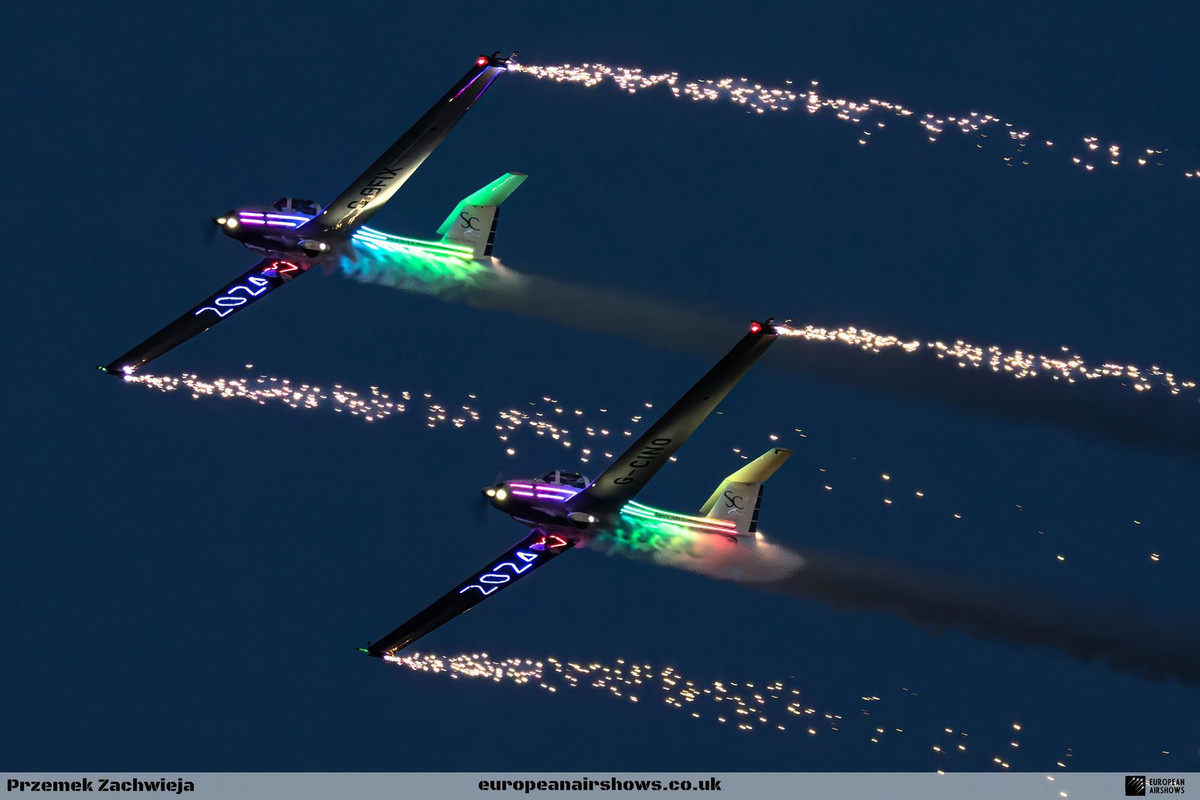
Airborne Pyrotechnics
About the Team
Airborne Pyrotechnics is a professional aerial display team sponsored by Sydney Charles Insurance Services and based near Warminster. The team is led by Tim Dews, an experienced pilot with over 30 years of experience flying the Grob 109b motor glider worldwide. Tim is joined by his son, Tom Dews, who accomplished his solo flight in the Grob at the age of 16, following in the footsteps of his brother, Ben Dews. Additionally, the youngest sibling, Matthew Dews, successfully soloed in a glider at the age of 14, taking advantage of evolving aviation regulations.
Tim and Ben Dews oversee the importation of Grob motor gliders for clients across the United Kingdom and manage a composite aircraft repair enterprise situated at the airstrip. Airborne Composites, the other division of Airborne Pyrotechnics, has played a crucial role in developing the sophisticated systems that power the team’s pyrotechnic displays over the past five years. The team offers a variety of display options, ranging from quiet to loud performances, utilizing formations of one, two, or three aircraft tailored for events such as weddings, garden parties, and airshows.
Team Overview
Number of Aircraft
2
Established
N/A
Based
Wing Farm Airfield
Aircraft Type
Grob 109b / Silence Twister / Grob Twin II
About the Aircraft
Airborne Pyrotechnics operates two Grob 109b motor gliders, which are the cornerstone of their aerial pyrotechnic displays. These motor gliders are renowned for their super efficiency, quiet operation, and graceful flight characteristics, making them ideal for both daytime and nighttime performances. Equipped with thousands of colored LEDs, integrated engine smoke systems, and 4 kilograms of pyrotechnics mounted on each wingtip, the Grob 109b can create visually stunning and synchronized pyrotechnic sequences. The ability to fly silently while deploying vibrant lights and smoke enhances the overall spectacle, allowing for a wide range of display styles from subtle illuminations to dynamic explosive effects.
The Grob 109b is a sophisticated light aircraft developed by Grob Aircraft AG of Mindelheim Mattsies, Germany. First introduced in its prototype form in 1980, the production G109A followed shortly after, with the G109B variant launching in 1984. As a two-seat self-launching motor glider, it features side-by-side seating with excellent visibility provided by large windows. Constructed primarily from glass-reinforced plastic, the G109B boasts a low-wing cantilever design with a T-tail and a taildragger undercarriage arrangement. Enhancements from the G109A to the G109B include increased engine power from 80Hp to 95Hp, improved wing performance in wet conditions, better crosswind handling, and expanded cockpit space. The aircraft is powered by a Grob 2500 E1 horizontally opposed, four-cylinder, air-cooled petrol engine, capable of producing approximately 95 horsepower. Its versatility is further demonstrated by its use in both civilian roles and by the Royal Air Force Volunteer Gliding Squadrons (VGS) for training air cadets until its retirement in 2018.
In addition to the Grob 109b fleet, Airborne Pyrotechnics utilizes the Silence Twister, a German ultralight aircraft designed for amateur construction. The Twister is a single-seat, low-wing monoplane inspired by the iconic Supermarine Spitfire, featuring elliptical wings and a tailplane that evoke the classic World War II fighter’s aesthetics. This bespoke aerobatic aircraft is equipped with high-intensity LED lights, advanced engine smoke systems, and pyrotechnic devices on the wingtips, making it perfectly suited for both day and evening displays. The Twister’s design prioritizes agility and responsiveness, enabling rapid changes in direction and elevation necessary for dynamic pyrotechnic performances. Its ability to execute rapid loops, rolls, and other aerobatic maneuvers while deploying visual effects makes it a vital component of the team’s complex aerial showcases.
Completing their specialized fleet is the Grob Twin Two, a two-seat aerobatic glider equipped with wingtip pyrotechnic units. This high-performance sailplane is designed for training, cross-country racing, and simple aerobatic flying, featuring a T-tail configuration and upper-surface airbrakes. The Twin Two is constructed from fiberglass, providing strength and lightweight performance essential for intricate maneuvers. The dual controls facilitate seamless teamwork between pilots, enabling precise and stable execution of complex aerial maneuvers that significantly amplify the visual impact of the team’s pyrotechnic displays.
Team History
Airborne Pyrotechnics was established through the combined expertise of the Dews family, leveraging Tim Dews’ extensive background in piloting and aircraft maintenance. Over the years, the team has expanded its capabilities by incorporating advanced pyrotechnic technologies developed by Airborne Composites. This integration has enabled the team to deliver complex and visually stunning aerial displays, adapting to the diverse needs of various events.
The team has evolved to include multiple generations of the Dews family, with each member contributing to both the operational and technical aspects of the organization. Tim’s leadership and the contributions of his sons have been pivotal in establishing Airborne Pyrotechnics as a reputable provider of aerial pyrotechnic services in the UK. The diversification into importation and aircraft repair has further solidified the team’s presence in the aviation and entertainment industries.
Did You Know?
- Airborne Pyrotechnics is led by Tim Dews, who has over 30 years of experience flying the Grob 109B worldwide, and his son Tom, who soloed in the Grob on his 16th birthday.
- Each Grob 109B motor glider used by Airborne Pyrotechnics is equipped with 4 kg of pyrotechnics on each wingtip, enhancing their mesmerizing air displays.
- The Grob G109 was the first motor glider built using composite materials to receive approval from the Federal Aviation Administration (FAA).
- The Grob 109B, known as the Vigilant T1 in RAF service, was utilized by the Royal Air Force Volunteer Gliding Squadrons to train air cadets until its retirement in 2018.
- The Grob 109B motor gliders are renowned for their super-efficient, quiet, and graceful flight capabilities, capable of night flying with thousands of colored LEDs and engine smoke effects.


































